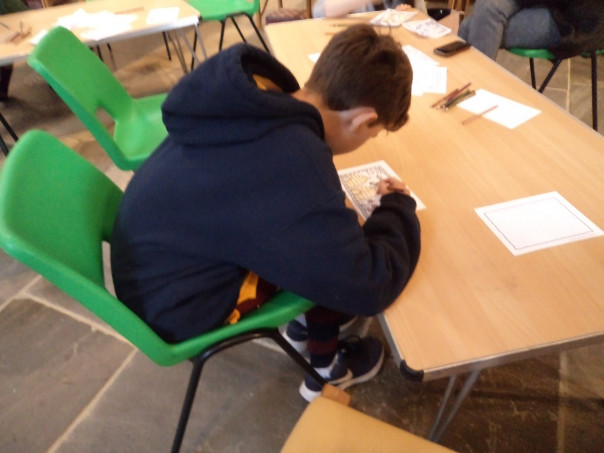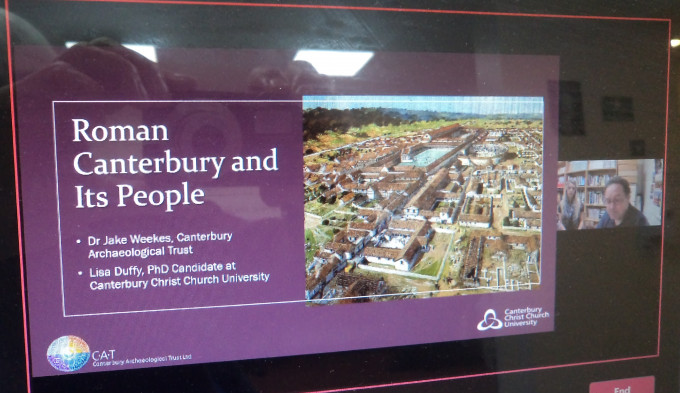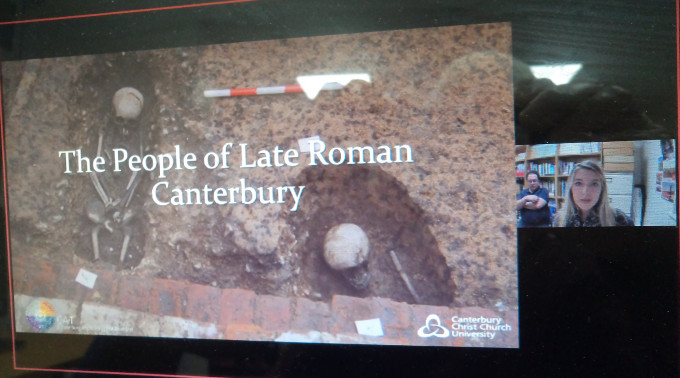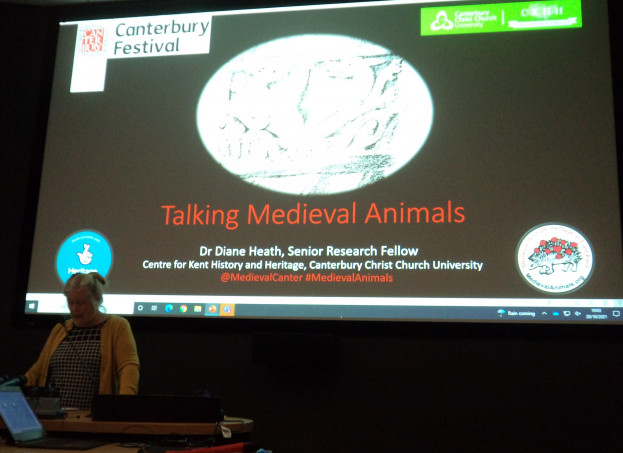As in previous years, the CKHH was in charge of a location as part of the Family Heritage Trail around the city as part of the Medieval Pageant. Rather than in its normal July, this year it was last Saturday as part of the Canterbury Festival and, as Dr Claire Bartram and her son saw, the procession through the city included a new giant in the form of Thomas Becket. This giant was part of a schools’ competition, the design based on one provided by Ben, a Medieval and Early Modern undergraduate as part of the Applied Humanities module last April organised by Claire Bartram.

As in 2019 the Centre was based in St Paul’s church, so firstly many thanks to the Revd Mark Griffin for allowing us to use the church and for supplying mugs of tea during the day. This time we were working with Penny Bernard from the ‘Medieval Animals’ project and several student helpers: Marci, Eli, Emelia and Kiamae, as well as a couple of primary school student teachers who came to try out the family-orientated activities. Claire, having taken on the Medieval Pageant from Professor Louise Wilkinson this year, was delighted to see that we had a good number of families and in total over 150 people came into St Paul’s church. We were fortunate that Penny and Dr Diane Heath are busy setting up their NHLF-funded ‘Medieval Animals Heritage’ project which meant that we could try out the ‘medieval animals’ i-spy, colouring activities of certain fabulous beasts and provide badges for our ‘young medievalists’. These family-centred activities were a huge hit and the hedgehog badges, the project’s logo, were the most popular. The rest of the ‘Medieval Pageant’ was equally successful and the Canterbury BID were delighted with the outcome, not least because more chocolate coins were handed out than in previous years to those who had visited 5 or more locations.

Turning now to other matters involving the Centre this week, we have had the first three of our six Canterbury Festival talks, and tomorrow (Friday) will be my guided walk around Canterbury. Additionally, the Kent History Postgraduates met online this week for Jane Richardson’s presentation on the early charters of Tonbridge Priory. This will form part of Jane’s chapter on foundation and patronage of her three religious houses. The central issue Jane has been wrestling with is just which member of the de Clare family founded the priory of Augustinian canons in the 12th century and how this sits with the activities of other family members, others from within their aristocratic circle, and those of lower status such as their tenants. The reason why this has proved problematic is that until recently a papal bull confirming the existence of the place was one of the few early documents that could be dated, while the only other clue was that the founder was ‘R de Clare’.

However, by working those the early charters in a cartulary at the Bodleian Library, as well as documents at The National Archives, and collating the names of donors, recipients and witnesses, Jane has been able to make some remarkable discoveries. She has now narrowed down the priory’s foundation year from somewhere between 1140 and 1191 to between 1173 and 1181, with the founder being Richard de Clare earl of Hertford. Furthermore, she is now in a much stronger position to be able to discuss the context of this foundation, the level of support the priory experienced in its early decades and from whom, as well as how extensive its holdings were and what types of relationships benefactors wished to establish with their chosen institution. This is an excellent achievement and Jane will follow this up by doing the same exercise for her other two religious houses.
I now want to turn to the Centre’s Festival lectures, our first given on Tuesday evening by Dr Jake Weekes (Canterbury Archaeological Trust) and Lisa Duffy (Archaeology doctoral student at CCCU). Taking their subject of Roman Canterbury and its people, Jake began by explain that the city’s development should be seen as three phases in Roman times and only the third phase involved the city wall, constructed 270 to 290 AD. This had a major impact on the topography of the city, especially on the St Dunstan’s, western side of Canterbury, the city bounds shrinking markedly from the early phase cemetery close to what is still called the London Road. Consequently, not only were such cemeteries barely used but other cemeteries came into being much closer to this new city wall and ditch and one such cemetery was on the site of what became Hallet’s garage, but more on that later.
Jake also pointed out the different road alignments to places such as Richborough and later Dover to demonstrate not only the changing Roman townscape of roads, civic, public and private buildings, but how even the material culture found during various excavations continues to inform us about the city’s Roman inhabitants, and their commercial, social and religious practices. Thus, as well as summarising what we know about Canterbury’s forum, theatre and temple precincts, Jake provided a brief assessment of the various cemeteries on the Augustine House and neighbouring building sites before passing the mic to Lisa.

Lisa is working on skeletons from three late Roman Canterbury sites: Hallet’s Garage, the Peugeot garage and Rhodus Town that together offer material from over 350 graves. This remarkable total assemblage is very valuable as a means to explore matters such as health, diet, migration, levels of physical activity, and injury that together start to help us understand what life was like in the past relating to social status, behaviour, age and gender. For example, stress leads to a physiological response which can be seen in someone’s bones and by exploring these populations Lisa can see what proportion of certain age and gender groups demonstrate such effects. Thus, her study is a mix of looking at populations as a whole and then concentrating on specific individuals, almost on a biographical basis. Amongst her findings is evidence of men whose work activities led to their developing considerable upper arm strength, while female skeletons highlight the incidence of what we now call tennis elbow.
Other findings concern the skeletons of children, many of these relate to nutritional stress and growth disruption, the product of such matters as dietary deficiencies, including specific vitamins and minerals. Other bones, including skulls show evidence of incomplete healing, which may relate to neglect or other trauma suffered by these individuals. What Lisa called inter-personal violence was not confined to this group and other individuals had probably suffered life-threatening injuries, including a potential gladiator. Such findings were fascinating, and their joint presentation engendered a wide range of questions from the online audience.

Then on Wednesday evening we moved to the Powell Lecture Theatre for Dr Diane Heath’s presentation on ‘Talking Medieval Animals’, which was also livestreamed due to the excellent instructions provided by Toby Charlton-Taylor in the AV department. Diane began by outlining her NHLF-funded project and how she will be helping disadvantaged and disabled children in east Kent to engage with their emotions through exploring the characteristics of medieval animals. For as she said, animals provide lively lessons, something that was well understood in the Middle Ages through the creation of bestiaries – ‘books of beasts’ based on classical and early medieval texts that were adapted, drawn on and appropriated by later theologians such as St Anselm and Honorius Augustodunensis, who were especially influential at Canterbury. Thus, beasts were and are good to think with, especially when considering moral and spiritual matters, and perhaps more in 21st-century terms how we interact with others – the idea of giving and receiving respect.

Having set out the more theoretical ideas, Diane then took her audience on a safari around the churches of Kent to highlight just how many beasts there are in stained glass windows, stone carvings – on column capitals, above doors, on towers, wall and column paintings, wooden bench ends and misericords, metalwork – jewellery, but also the fabulous door at All Saints’, Staplehurst, and the lead font at St Augustine’s, Brookland, floor tiles, and embroidery –altar frontals, copes and other vestments, curtains, towels and palls. Moreover, these animals were employed in a wide range of scenarios in ecclesiastical buildings, whether they were saints’ emblems, in heraldic settings, part of the labours of the months or were centre stage from their bestiary significance, but in all cases the animal mattered, it was not a random choice. Consequently, Diane is keen to find volunteers and families who want to engage in this project to in a sense bring these animals back to life, so that they start talking once again to today’s generation as they did to medieval people. If you are interested, please do email Diane at diane.heath@canterbury.ac.uk
Turning now to our third online Festival presentation, this evening we showed Dr Sam Vale’s short film on collecting and cherries, especially cherry blossom. Sam is about to leave CCCU for Coventry and this delightful swansong – see, I knew I could get a linking reference – demonstrates his talents as an expert photographer with a great eye for detail and the beauty of the Kent landscape. His film offers a visual feast highlight the three different forms of collecting: fetish, souvenir, and systematic, through different ways of exploring the history of cherry growing in Kent and its decline over the last few decades. For his fetish collecting, we were able to join him through his photos of hand-made signs, often on grass verges, at farm gates or in lay-bys that crop up for short periods during the short cherry season – a factor noted in the late medieval play ‘Mankind’ – that took him across much of east Kent where the soils are ideal for cherry growing. It many ways this might be said to be the most joyous collecting for it shows off the Kent landscape in early summer, somewhat of a contrast to Sam’s second collection of road signs, housing estates and old postcards. For many cherry orchards are now no more than a distant memory, the trees, growers and pickers long gone, replaced by modern houses, tarmac and galloping suburbia, the decline of the cherry potentially symptomatic of the state of British agriculture in the Home Counties. Nevertheless, as Sam noted, it is not totally doom and gloom because places like the National Plant Collection at Brogdale, near Faversham, still exist, which brought him to his third collection. Drawing on the inspiration of 19th-century naturalists who painstakingly drew and painted specimens to produce a taxonomy, Sam showed his audience examples from his photographic taxonomy of cherry blossom from the 323 varieties, including local specimens such as Goodneston Black and Malling Black Eagle. To complement his blossom taxonomy, Sam mentioned that he has also pressed examples from 310 cherry varieties, these different aspects offering a fascinating and beautiful film.

Following on from his film, Sam discussed what he had found most satisfying about his collecting, especially the often unexpected nature of finding roadside cherry signs, the thrill of never knowing when he would find another sign. This was in some ways in marked contrast to the taxonomy because even though not all the cherry varieties at Brogdale flowered each spring, he knew from the beginning how many varieties he needed to complete his collection, which meant that in some ways it was more a waiting game with the satisfaction of being able to cross off a variety once it had been photographically recorded. For Sam, too, the landscape, although in some ways incidental, was also important, for as he noted Turner was one of those who had been able to make considerable use of the Kent countryside and its coastal regions in his many paintings. Thus, Sam too had enjoyed the ‘great skies’, as well as still the greenness of much of the county’s landscape. Finally, Sam took several questions from audience members, including answering questions about his book on cherry taxonomy.
Thus this was a successful series in terms of audience appreciation and next week we have three more speakers, as well as a report on the Maritime Kent through the Ages book launch tomorrow (Friday) at Faversham, the conference on this topic taking place of Saturday 6 November. For those wanting the links for next week’s talks and the Maritime Kent conference, please find them at: https://blogs.canterbury.ac.uk/kenthistory/canterbury-festival-lossenham-and-maritime-kent-looking-forward/ and we hope you will join us.
 Centre for Kent History and Heritage
Centre for Kent History and Heritage Sheila Sweetinburgh
Sheila Sweetinburgh 1143
1143

